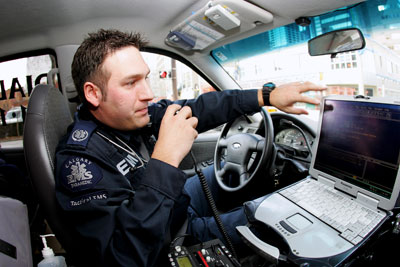Mobile Diagnosis

Having a readily accessible set of records for standard patients and those in the midst of medical emergencies has been a distinct need for some time. (Photo Kevin Link)
In the midst of the holidays, immersed in the revelry represented by gatherings of friends, colleagues and family, many across our nation will take a physical and mental respite from the ever-present tribulations of life — and rightfully so. We do our best to set aside differences and difficulties, to turn down both the gain and the volume on the device that is our life.
As the annual deceleration occurs, public safety professionals understand that during this time of the year an acceleration of the rate at which their services are needed occurs in kind. It is a regrettable fact that each year we see, for example, an increase in heart attacks during the holiday season. Opinions vary as to the causes.
An unfortunate fact is that emergency personnel often arrive at homes, office parties and restaurants, or rendezvous with transportation system conveyances, with minimal — if any — crucial patient information at the ready.
Sending the Doc or the Data
Until recently, the majority of health service-based communications technology developments have focused on medical records. Having a readily accessible set of records for standard patients and those in the midst of medical emergencies has been a distinct need for some time, and an array of companies and public agencies have developed a series of means to address this still growing concern.
A focus on the collection and transmission of a patient’s vital signs, as well as results of on-the-spot diagnostic scans, has come about a bit more slowly. The much more recent development of diagnostic technologies, as opposed to the longer history of records-based functions, speaks to the discrepancy in timing to some extent. Nevertheless, an influential and indispensable component of such a system will always be the means by which the data is transferred from the field to a full-service medical treatment center and back — the wireless data network.
The rapid expansion of broadband networks and the ever-increasing sets of data and applications that already ride on these systems has, in part, provided impetus for the development of devices that extend the expertise and insights of physicians located in fixed facilities into the field. A robust and always accessible network is a must as emergency medical professionals access telemedicine systems, high-resolution video and patient records to reduce the time it takes to deliver medical services on scene at an incident, such as a car crash on a highway, or during an emergency response to a home or office where someone has collapsed or been injured.
Mobile diagnostic tools and techniques are being implemented already. Today, commercial airline crews can work with land-based physicians using mobile diagnostic devices to assess potential medical emergencies while in flight. This allows airlines to provide passengers in need with timely links to medical attention. If it’s determined that a patient’s condition is stable enough for the crew to continue the flight as planned, the provision of emergency service has been enhanced, while at the same time subsequent difficulties in transportation logistics related to a potential flight diversion have been avoided.
Seeing the Signs
In addition to treatment advice and crosschecking of records, real-time monitoring exists as a possibility in the field of public safety. Such systems are being considered and tested by military units around the globe. But how about the civil contingencies services? Fire and rescue workers deploying into a building, outfitted with vital signs monitoring and movement tracking systems, could perform their always difficult duties in an environment where their physical condition is constantly monitored by trained medical professionals, thereby significantly enhancing their safety.
These first responder focused technologies can be augmented by victim-focused technologies, such as probes designed to scan for internal injuries and the like. Together, such an array of health communications technologies could offer to the field of public safety new service efficiencies that should reduce the cost and danger of emergency response, with the concurrent windfall of enhanced lifesaving capacity.
The Broadband Link
It is certain that these considerations are not revelations at this juncture in the development and deployment of emergency medical technology. The vast pool of possible uses for such devices has existed on design boards and in the spotlight during investor pitches for some time now. What is somewhat different at the moment is that we have seen just enough of these or similar technologies to both whet the appetite and make it inevitable that they will soon be used every day to better serve the public. This is just over the horizon, but fully dependent on the establishment of a nationwide public safety broadband network to bring it to fruition. Data without data sharing adds only more silos to the landscape of interoperability.
The holiday season will again be visited by unfortunate medical emergencies. As we make the transition to a new year, it will be with the same determination as the previous one that public safety professionals of all walks call upon the new Congress to commit to and deliver on a resolution to provide public safety with the tools needed to make the public safe.
About the Author
George S. Rice Jr. is APCO’s executive director. Contact him via e-mail at riceg@apcointl.org.
Originally published in Public Safety Communications magazine, Vol. 76(12):13, December 2010.

